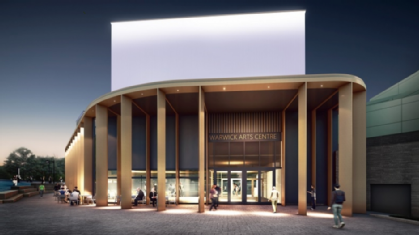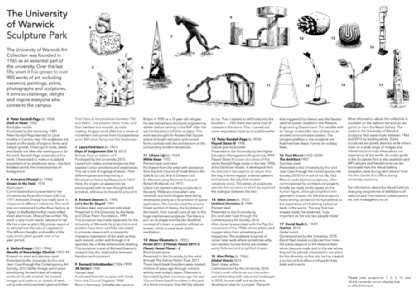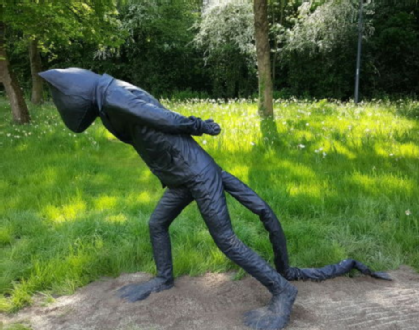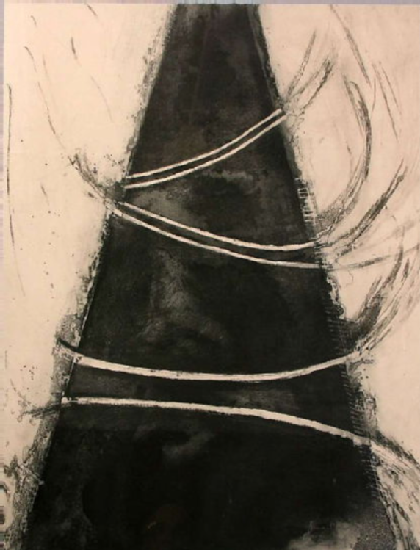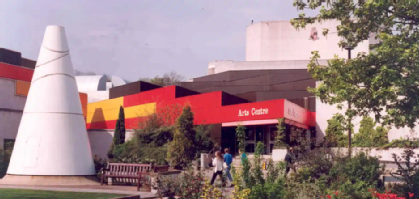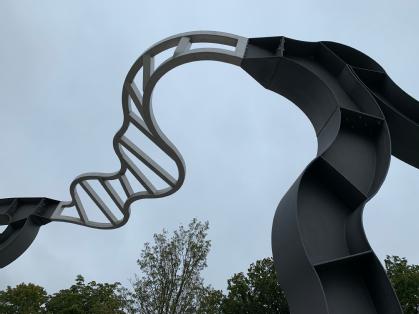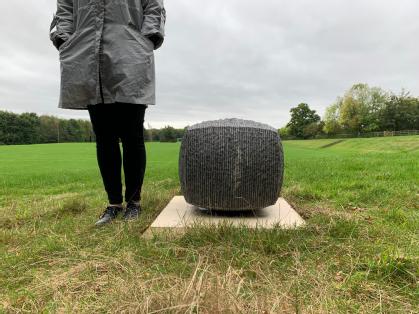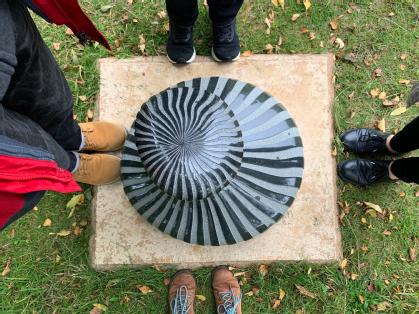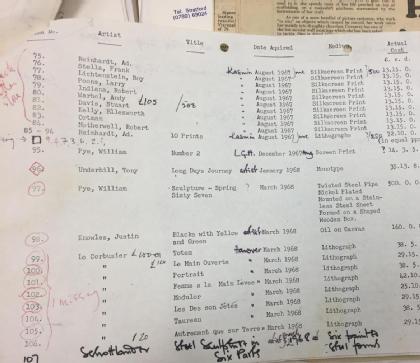Art Collection
It is undoubtable that the university has changed a lot over the years and so has its art collection. It has grown, and its purpose has too, even though the values at the heart of the university’s art collection do not seem to have shifted that much: they remain centred on student body participation. This is something that has been clear since the beginning of when Warwick was founded in 1965, as it was part of the governmental initiative seeking to expand higher education. The university art collection started small, from 1966, with a major role being played by the architect that was charged with designing the campus, Eugene Rosenberg, as well as the contractor for the project Alistair McAlpine.
In this first phase, mostly large-scale abstract paintings by male artists were collected, which was then followed by prints by contemporary British artists in the 1970s. In the 1980s, the collection was expanded even more, with several loans from the Rugby borough council and the Scottish Arts Council. During the following decades, the focus moved on acquiring art from local artists, which makes sense considering the artistic potential of Coventry.
One of the people that has played a crucial role in the development of the art collection is the first appointed curator, Katharine Eustace, who organised the first formal display of the collection in Mead Gallery in 1991. The Gallery itself was an important addition to the campus and a significant development for the arts collection. The plans to have it built in 1970 triggered student protests, who called for a union building to be added which would offer students more space for socializing, whilst the university was looking to add more space with commercial value. This is an interesting point, especially considering the backlash that the university has received in the past two years following their response to events on campus, such as the lengths to which they went to cover their reputation amid the group chat scandal, which led to accusations that the university is putting their reputation and business before the students’ interests. To what extent can the university be criticised for this, considering that the amount of money allocated to universities by the government was down by 20% by 1986? This is a question that is tricky to answer. It is all the more relevant nowadays, when cuts in the government’s budget for the arts have continued to be implemented.
What is certain is that Warwick has continued to invest in expanding the arts collection, setting up a fund to continue adding new pieces to the collection, which nowadays includes over 1000 works spread around campus. This has been matched by donations as well as grants, such as the £4.2 million grant from the Arts Council England secured in which will go towards the 20:20 Project, including the redevelopment of the Warwick Arts Centre (Image on the right).
The site-specific works that are dotted around campus make up one of the most important points of intersection between the university’s art collection and the student body. A lot of these were acquired through the Contemporary Art Society’s Special Collection Scheme, and they continue to provide a major point of interests for students and visitors alike. The Sculpture Trail (Image on the right) has been advertised by Mead Gallery as one of its main activities, which makes it all the more significant during the period of closure of the gallery for the 20:20 project. The most up-to-date map of the sculpture trail includes 13 sculptures, scattered around campus, most of them in the central area around the arts centre, and a couple further out around Milburn House and Westwood.
One of the most visible pieces is Laura Ford’s Days of Judgement (Cat 1) (Image on the right) from 2012, listed as number 5 on the sculpture trail map and placed opposite the bus interchange on campus. Its location means that it gets seen by most students on their daily journeys to study, attend lectures and seminars or join in on societies activities. Some students have really strong feeling towards this sculpture:
“Having lived in Coventry in my second year of studies means that I had to take the bus to campus nearly every day, so I was at the bus interchange quite a lot. I always found the cat sculpture somewhat terrifying, with its head bent down, as if almost human.”
Lou-Ann Albiol Ducos, 4th year History of Art and French student
The emphasis placed on the interaction between the student body and the arts collection warrants this sort of reaction, as contemporary art is in many ways the catalyst for strong reactions. The rest of the sculptures from the trail, as well as Ford’s Cat, are invaluable both to students and staff as they stimulate curiosity as well as opening the dialogue about relevant issues, in Ford’s case regarding human emotion and weakness.
90 works from the arts collection are currently housed by the Humanities Building, where most Faculty of Arts students attend seminars and lectures, and have their home departments. The pieces exhibited on the walls of this building include Liliane Lijn’s drawing “Black Koan” (Image on the right), which is hung in the ground floor corridor, a work of art that most students frequenting this building would be used to seeing. It is a visual representation of the same artist’s “White Koan” sculpture (Image on the right) which has been very popular amongst students throughout the years. Records from 1990 show that there was a Koan Society at Warwick that year, which was not official but rather grew out of the Science Fiction society. Events held by this society included a marriage ceremony between the Koan and a female student, offerings of beer and pizza during bar crawls held on campus, as well as selling Koan badges and earrings in the Rootes Bar area. Nowadays, the Koan-worshiping has somewhat diminished, as the sculpture was moved from central campus where it was placed right next to the Arts Centre, to the Medical Sciences side of the campus, right outside the Clinical Trials Unit. In the words of some of Warwick’s incoming graduates:
“The Koan was the meeting point for the nights out organised by sport clubs and societies on campus. So, it was a really big part of my student experience. Most nights out on campus would usually involve post-clubbing selfies with the Koan so having it off main campus took that away, but the memories remain.”
Helena Lönnberg, 3rd year English Literature and
Creative Writing student
“Out of all the art works spread around campus, the Koan is the most iKoanic.”
Connie Slater, 3rd year English Literature student
The Koan has been remarkably less present in the lives of the 2019-2020 freshers compared to previous intakes. It will nevertheless remain in the memory of most students as one of the iconic images of Warwick and their time at university. The fact that students from 2018 and those from 1990 have similar experiences regarding the student appreciation for this sculpture, even if for some people it is somewhat humorous because they consider the sculpture to be visually displeasing, goes to show that the arts at Warwick have always had a strong weighing in student life and student experience.
Two instances of direct student participation have stood out in the past. First of it was in 1982 when some students asked the university team behind the arts collection to add labels to the works displayed on campus, which they were lacking at the time. The university thus commissioned the labels which were purchased for the mere price of £1.35 each. The second instance came during the 2010s, from a student outside the Faculty of Arts, who swapped one of the abstract painting’s label with a new one made by them, criticising the painting. These are just two examples of the way in which the lives of the students from all faculties and the arts collection intersect.
What is clear is that the curatorial team behind the collection, headed by curator Sarah Shalgosky, have emphasised how all interactions should be stimulated, regardless of how students understand the works. Sarah has been part of the curatorial team for many decades and her interest in making art available to students is evident. Her devotion to the university and the arts collection is paramount and it shows through her interest in having students’ voices heard in the development of the collection, as well as willingness to help them get experience in the arts world within the community that is Warwick. The strong bond between the Mead Gallery and the student body that already existed before the gallery was closed will be once more reaffirmed when the new Mead will open in 2021, with versatile positions to be offered to students similarly to what was offered in the past and which has greatly benefitted those who are looking for work experience in the field or simply for a part-time job alongside their studies.
BIBLIOGRAPHY
Campus Developments, https://warwick.ac.uk/about/community/projects/campusdevelopments/
Feilden Clegg Bradley Studios, https://fcbstudios.com/work/view/warwick-university-faculty-of-arts
History of the University, https://warwick.ac.uk/about/history/
Imagining a University: Fifty Years of The University of Warwick Art Collection (Cornerhouse Publications, 2015)
New Arts Building, https://warwick.ac.uk/fac/arts/aboutus/artsfacultyfacilities/newartsbuilding/faq/
Sculpture Trail, https://warwick.ac.uk/services/art/resources/sculpture/
University of Warwick Sculpture Trail, https://warwick.ac.uk/services/art/resources/sculpture/sculpture_map_a4.pdf
Warwick 20:20 Project, https://www.warwickartscentre.co.uk/2020/
Warwick Art Collection, https://warwick.ac.uk/services/art/
Warwick Modern Records Centre, https://warwick.ac.uk/services/library/mrc/

